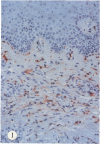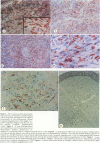Abstract
Kaposi's sarcoma is a neoplasm that develops as multifocal lesions, often involving the skin, characterized by a complex histologic picture including numerous vascular spaces, perivascular and interstitial spindle-shaped cells, and extravasated erythrocytes, lymphocytes, and plasma cells. Using an antibody against factor XIIIa, which identifies dermal dendrocytes, numerous factor XIIIa-positive dermal dendrocytes were detected among the spindle-shaped cells in 12 acquired immune deficiency syndrome (AIDS)-associated, and five non-AIDS-associated Kaposi's sarcoma lesions. The factor XIIIa-positive dermal dendrocytes were also increased in histologic simulators of Kaposi's sarcoma such as dermatofibroma, angiomatoid malignant fibrous histiocytoma, granuloma annulare, and early wound healing, but were absent in keloids. The increased number of dermal dendrocytes, which are often in an angiocentric configuration and which also express CD4, lymphocyte function associated antigen-1 (LFA-1), and Leu M3 in Kaposi's sarcoma, may be important to the angioproliferative response. The results suggested that the spindle-shaped cells that are present in a variety of cutaneous lesions are dermal dendrocytes and belong to the reticuloendothelial system, unlike other mesenchymal cell types such as the endothelial cell. Apparently a diverse array of stimuli, including human immunodeficiency virus type-1 (HIV-1) infection and trauma, can stimulate the accumulation of factor XIIIa expressing dermal dendrocytes in the skin. These cells can then participate in different stages of a variety of cutaneous alterations including Kaposi's sarcoma, dermatofibroma, granuloma annulare, and early wound healing. Thus, the factor XIIIa-positive dermal dendrocyte is a common cellular denominator among diverse clinical entities that share some histologic features.
Full text
PDF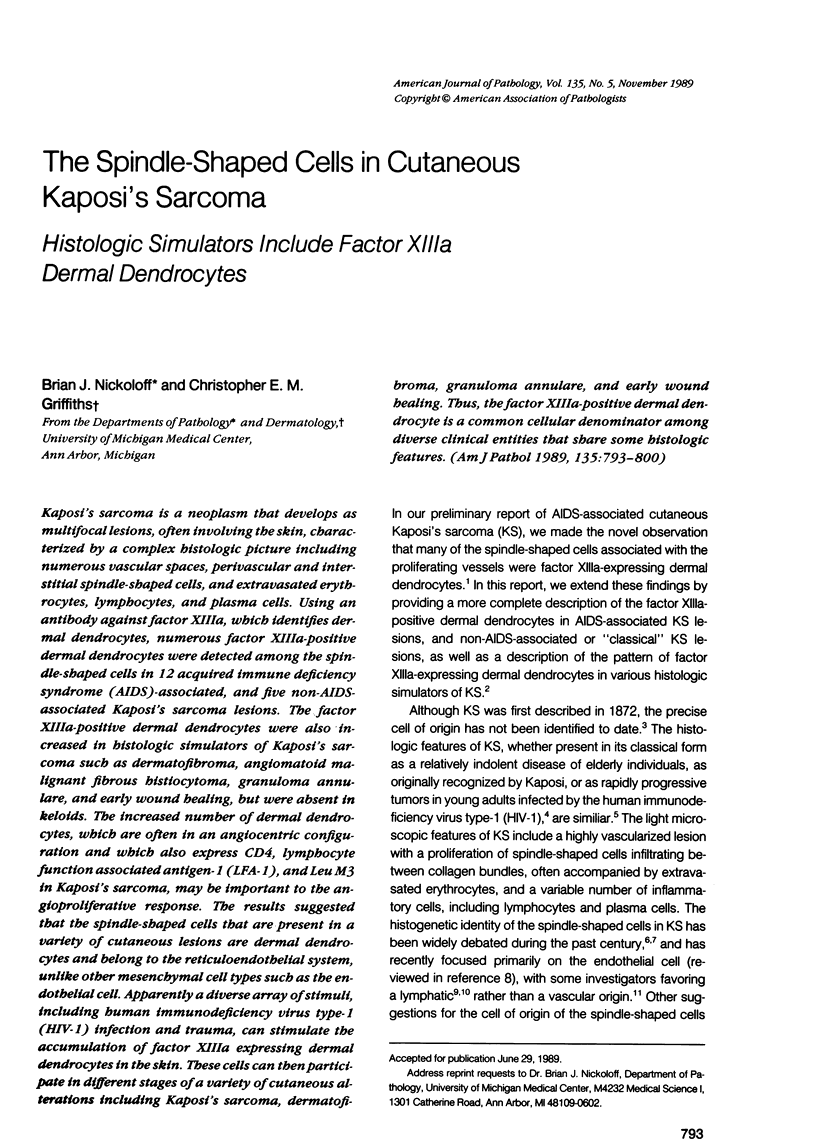
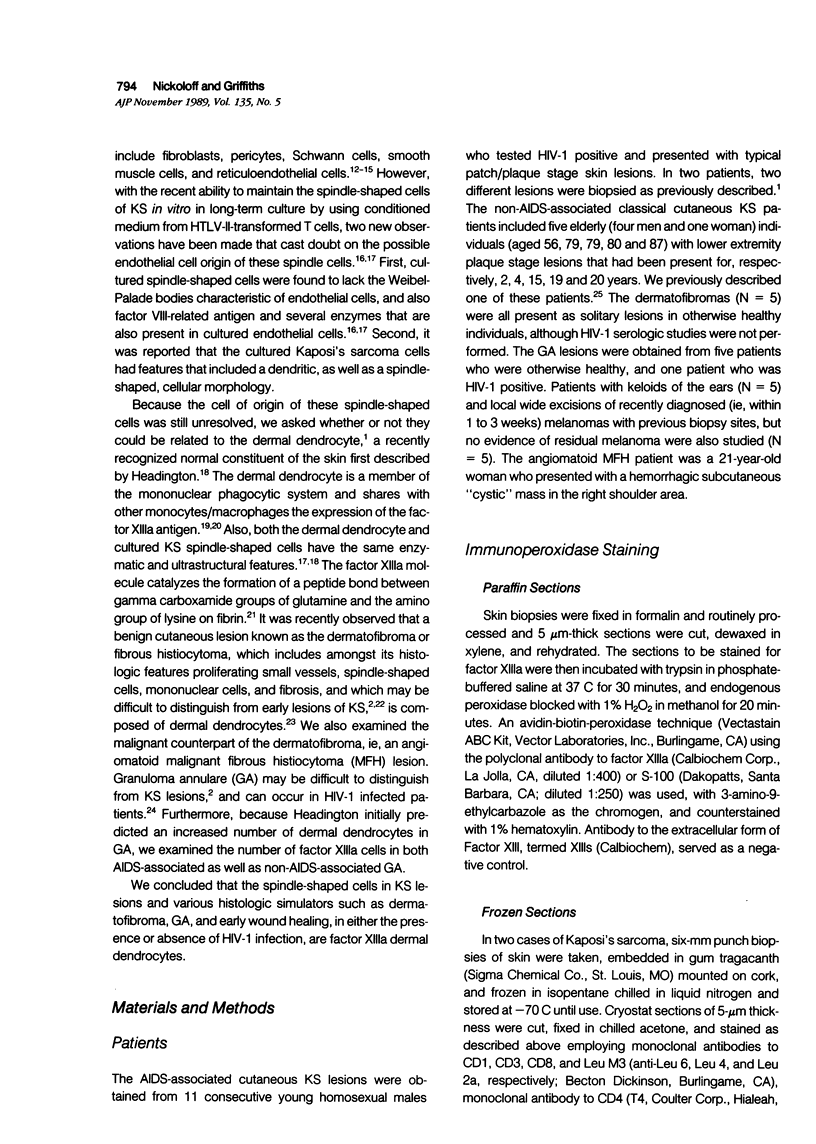
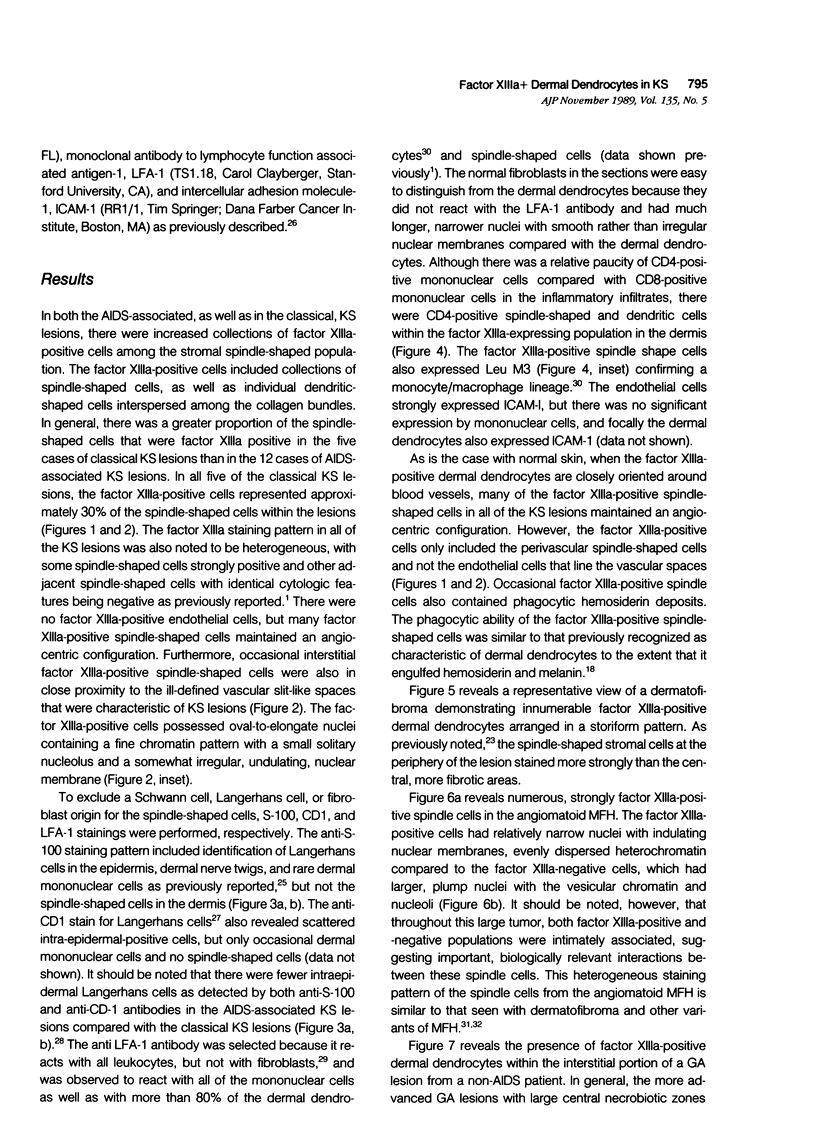
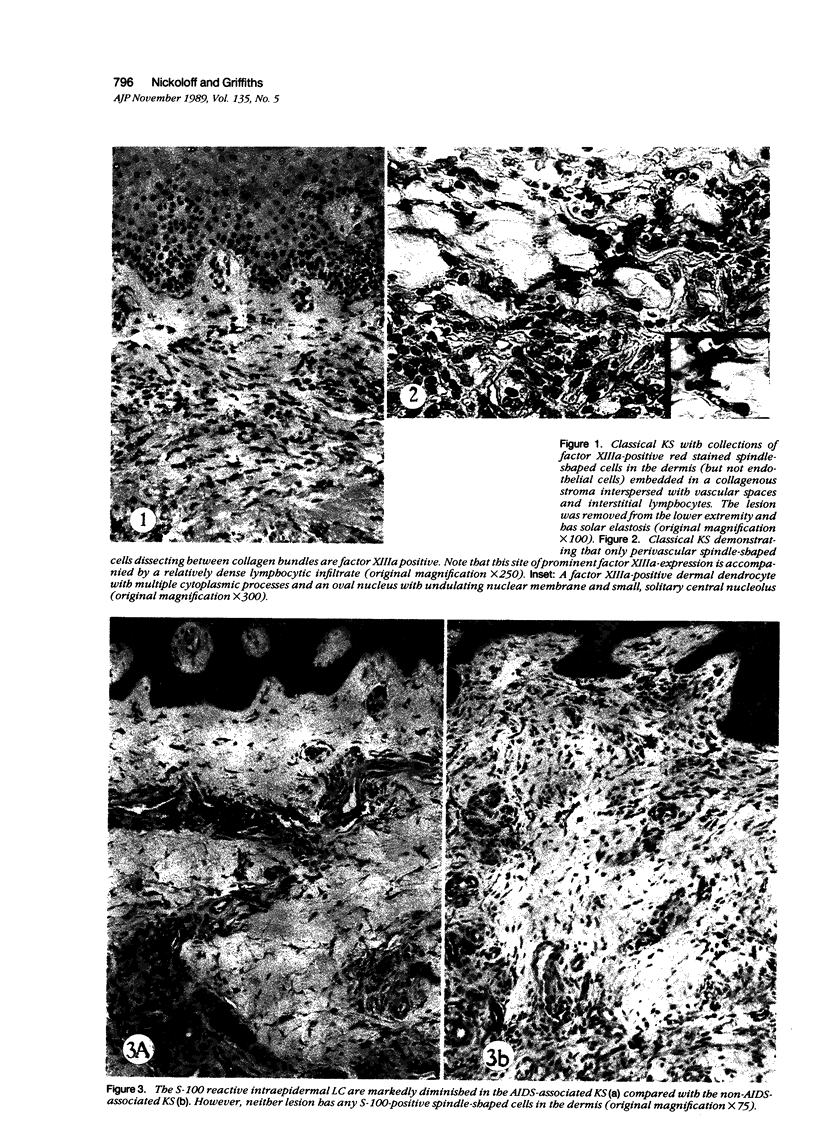
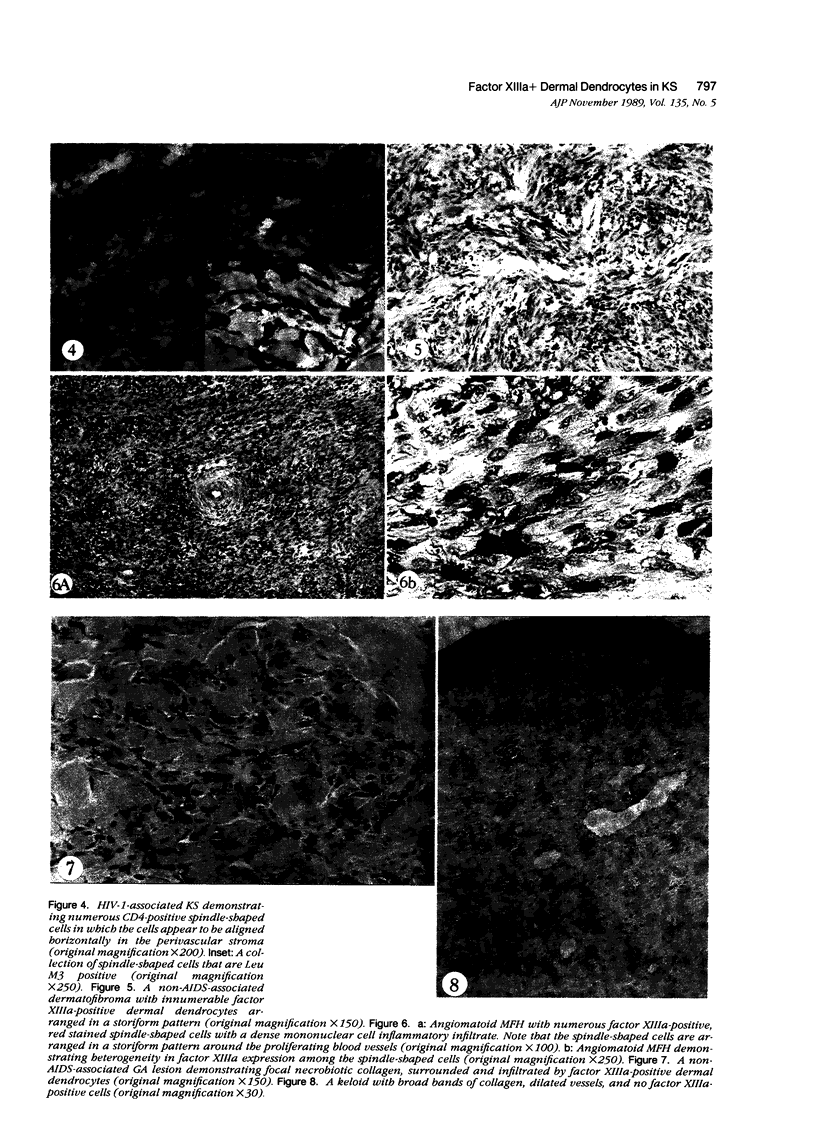

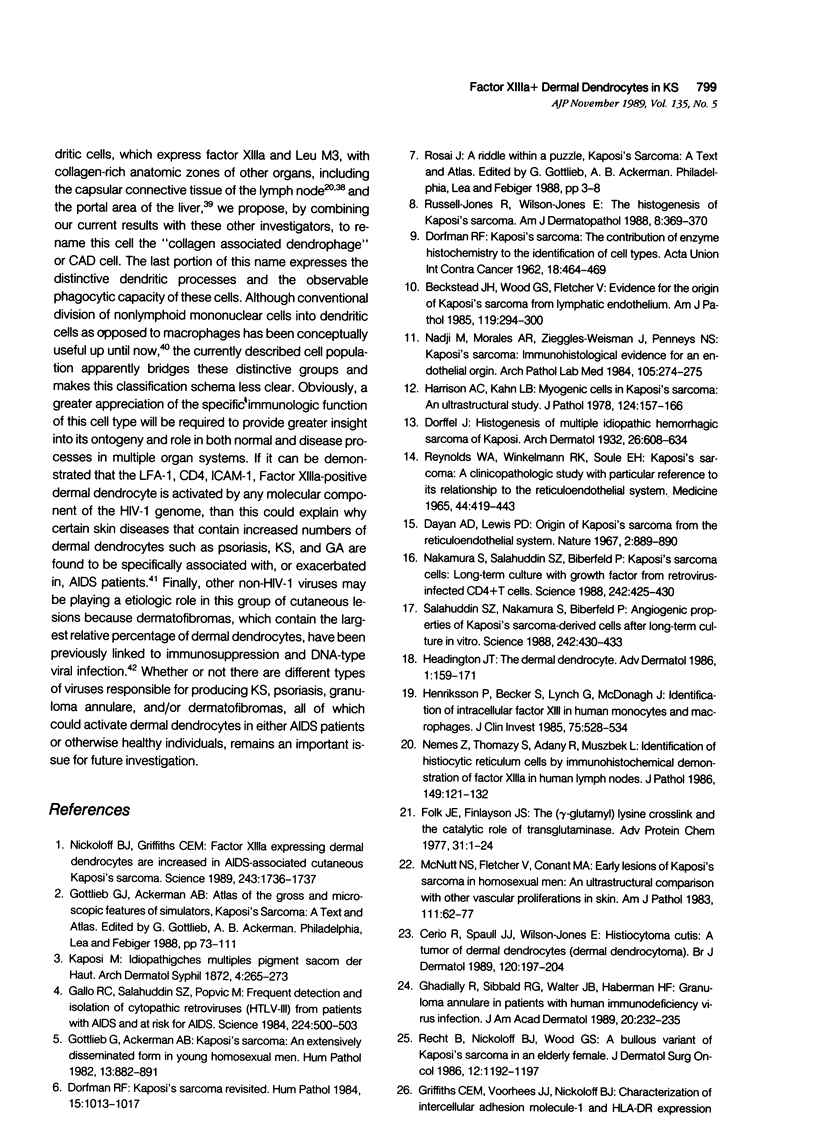
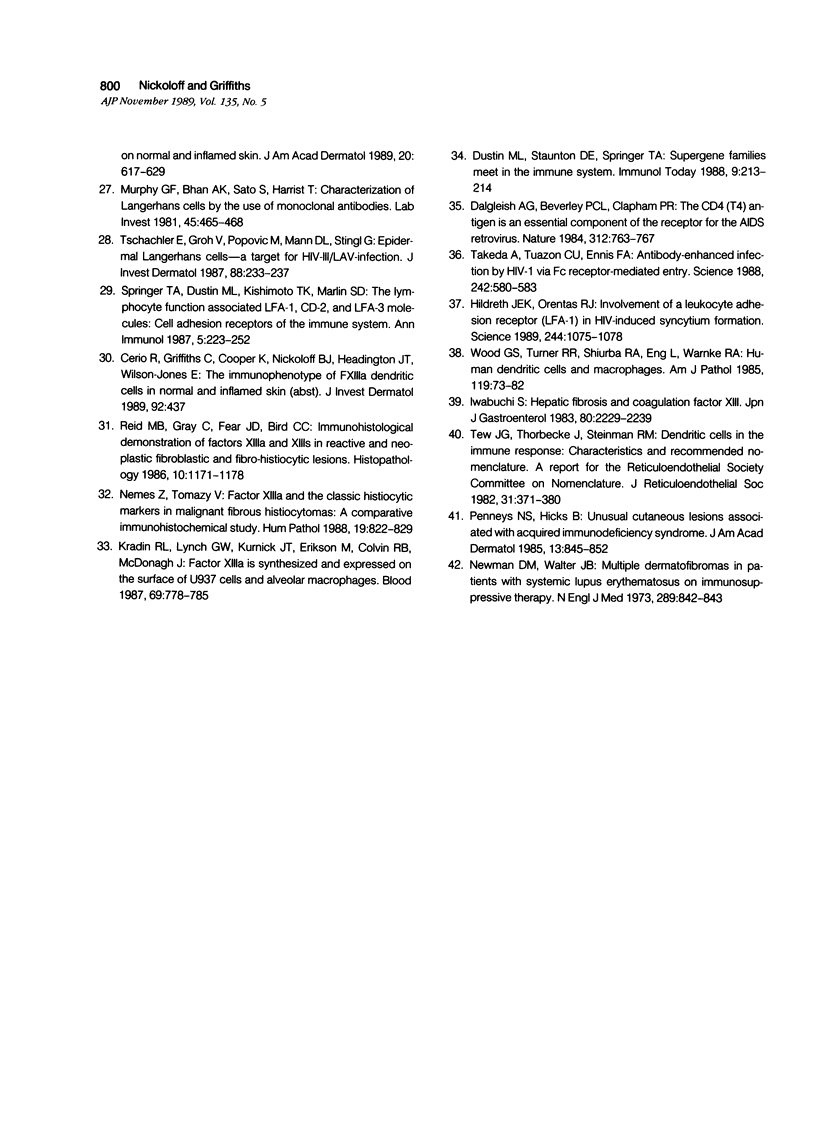
Images in this article
Selected References
These references are in PubMed. This may not be the complete list of references from this article.
- Beckstead J. H., Wood G. S., Fletcher V. Evidence for the origin of Kaposi's sarcoma from lymphatic endothelium. Am J Pathol. 1985 May;119(2):294–300. [PMC free article] [PubMed] [Google Scholar]
- Cerio R., Spaull J., Jones E. W. Histiocytoma cutis: a tumour of dermal dendrocytes (dermal dendrocytoma). Br J Dermatol. 1989 Feb;120(2):197–206. doi: 10.1111/j.1365-2133.1989.tb07783.x. [DOI] [PubMed] [Google Scholar]
- DORFMAN R. F. Kaposi's sarcoma. The contribution of enzyme histochemistry to the identification of cell types. Acta Unio Int Contra Cancrum. 1962;18:464–476. [PubMed] [Google Scholar]
- Dalgleish A. G., Beverley P. C., Clapham P. R., Crawford D. H., Greaves M. F., Weiss R. A. The CD4 (T4) antigen is an essential component of the receptor for the AIDS retrovirus. Nature. 1984 Dec 20;312(5996):763–767. doi: 10.1038/312763a0. [DOI] [PubMed] [Google Scholar]
- Dayan A. D., Lewis P. D. Origin of Kaposi's sarcoma from the reticulo-endothelial system. Nature. 1967 Mar 4;213(5079):889–890. doi: 10.1038/213889a0. [DOI] [PubMed] [Google Scholar]
- Dorfman R. F. Kaposi's sarcoma revisited. Hum Pathol. 1984 Nov;15(11):1013–1017. doi: 10.1016/s0046-8177(84)80243-9. [DOI] [PubMed] [Google Scholar]
- Dustin M. L., Staunton D. E., Springer T. A. Supergene families meet in the immune system. Immunol Today. 1988 Jul-Aug;9(7-8):213–215. doi: 10.1016/0167-5699(88)91216-9. [DOI] [PubMed] [Google Scholar]
- Folk J. E., Finlayson J. S. The epsilon-(gamma-glutamyl)lysine crosslink and the catalytic role of transglutaminases. Adv Protein Chem. 1977;31:1–133. doi: 10.1016/s0065-3233(08)60217-x. [DOI] [PubMed] [Google Scholar]
- Gallo R. C., Salahuddin S. Z., Popovic M., Shearer G. M., Kaplan M., Haynes B. F., Palker T. J., Redfield R., Oleske J., Safai B. Frequent detection and isolation of cytopathic retroviruses (HTLV-III) from patients with AIDS and at risk for AIDS. Science. 1984 May 4;224(4648):500–503. doi: 10.1126/science.6200936. [DOI] [PubMed] [Google Scholar]
- Ghadially R., Sibbald R. G., Walter J. B., Haberman H. F. Granuloma annulare in patients with human immunodeficiency virus infections. J Am Acad Dermatol. 1989 Feb;20(2 Pt 1):232–235. doi: 10.1016/s0190-9622(89)70027-x. [DOI] [PubMed] [Google Scholar]
- Gottlieb G. J., Ackerman A. B. Kaposi's sarcoma: an extensively disseminated form in young homosexual men. Hum Pathol. 1982 Oct;13(10):882–892. doi: 10.1016/s0046-8177(82)80047-6. [DOI] [PubMed] [Google Scholar]
- Harrison A. C., Kahn L. B. Myogenic cells in Kaposi's sarcoma: an ultrastructural study. J Pathol. 1978 Mar;124(3):157–160. doi: 10.1002/path.1711240305. [DOI] [PubMed] [Google Scholar]
- Headington J. T. The dermal dendrocyte. Adv Dermatol. 1986;1:159–171. [PubMed] [Google Scholar]
- Henriksson P., Becker S., Lynch G., McDonagh J. Identification of intracellular factor XIII in human monocytes and macrophages. J Clin Invest. 1985 Aug;76(2):528–534. doi: 10.1172/JCI112002. [DOI] [PMC free article] [PubMed] [Google Scholar]
- Hildreth J. E., Orentas R. J. Involvement of a leukocyte adhesion receptor (LFA-1) in HIV-induced syncytium formation. Science. 1989 Jun 2;244(4908):1075–1078. doi: 10.1126/science.2543075. [DOI] [PubMed] [Google Scholar]
- Iwabuchi S. [Hepatic fibrosis and coagulation factor XIII]. Nihon Shokakibyo Gakkai Zasshi. 1983 Oct;80(10):2229–2239. [PubMed] [Google Scholar]
- Jones R. R., Jones W. E. The histogenesis of Kaposi's sarcoma. Am J Dermatopathol. 1986 Oct;8(5):369–370. [PubMed] [Google Scholar]
- Kradin R. L., Lynch G. W., Kurnick J. T., Erikson M., Colvin R. B., McDonagh J. Factor XIII A is synthesized and expressed on the surface of U937 cells and alveolar macrophages. Blood. 1987 Mar;69(3):778–785. [PubMed] [Google Scholar]
- McNutt N. S., Fletcher V., Conant M. A. Early lesions of Kaposi's sarcoma in homosexual men. An ultrastructural comparison with other vascular proliferations in skin. Am J Pathol. 1983 Apr;111(1):62–77. [PMC free article] [PubMed] [Google Scholar]
- Murphy G. F., Bhan A. K., Sato S., Harrist T. J., Mihm M. C., Jr Characterization of Langerhans cells by the use of monoclonal antibodies. Lab Invest. 1981 Nov;45(5):465–468. [PubMed] [Google Scholar]
- Nadji M., Morales A. R., Ziegles-Weissman J., Penneys N. S. Kaposi's sarcoma: immunohistologic evidence for an endothelial origin. Arch Pathol Lab Med. 1981 May;105(5):274–275. [PubMed] [Google Scholar]
- Nakamura S., Salahuddin S. Z., Biberfeld P., Ensoli B., Markham P. D., Wong-Staal F., Gallo R. C. Kaposi's sarcoma cells: long-term culture with growth factor from retrovirus-infected CD4+ T cells. Science. 1988 Oct 21;242(4877):426–430. doi: 10.1126/science.3262925. [DOI] [PubMed] [Google Scholar]
- Nemes Z., Thomázy V., Adány R., Muszbek L. Identification of histiocytic reticulum cells by the immunohistochemical demonstration of factor XIII (F-XIIIa) in human lymph nodes. J Pathol. 1986 Jun;149(2):121–132. doi: 10.1002/path.1711490207. [DOI] [PubMed] [Google Scholar]
- Nemes Z., Thomázy V. Factor XIIIa and the classic histiocytic markers in malignant fibrous histiocytoma: a comparative immunohistochemical study. Hum Pathol. 1988 Jul;19(7):822–829. doi: 10.1016/s0046-8177(88)80266-1. [DOI] [PubMed] [Google Scholar]
- Newman D. M., Walter J. B. Multiple dermatofibromas in patients with systemic lupus erythematosus on immunosuppressive therapy. N Engl J Med. 1973 Oct 18;289(16):842–843. doi: 10.1056/NEJM197310182891606. [DOI] [PubMed] [Google Scholar]
- Nickoloff B. J., Griffiths C. E. Factor XIIIa-expressing dermal dendrocytes in AIDS-associated cutaneous Kaposi's sarcomas. Science. 1989 Mar 31;243(4899):1736–1737. doi: 10.1126/science.2564703. [DOI] [PubMed] [Google Scholar]
- Penneys N. S., Hicks B. Unusual cutaneous lesions associated with acquired immunodeficiency syndrome. J Am Acad Dermatol. 1985 Nov;13(5 Pt 1):845–852. doi: 10.1016/s0190-9622(85)70228-9. [DOI] [PubMed] [Google Scholar]
- Recht B., Nickoloff B. J., Wood G. S. A bullous variant of Kaposi's sarcoma in an elderly female. J Dermatol Surg Oncol. 1986 Nov;12(11):1192–1197. doi: 10.1111/j.1524-4725.1986.tb02104.x. [DOI] [PubMed] [Google Scholar]
- Reid M. B., Gray C., Fear J. D., Bird C. C. Immunohistological demonstration of factors XIIIa and XIIIs in reactive and neoplastic fibroblastic and fibro-histiocytic lesions. Histopathology. 1986 Nov;10(11):1171–1178. doi: 10.1111/j.1365-2559.1986.tb02557.x. [DOI] [PubMed] [Google Scholar]
- Reynolds W. A., Winkelmann R. K., Soule E. H. Kaposi's sarcoma: a clinicopathologic study with particular reference to its relationship to the reticuloendothelial system. Medicine (Baltimore) 1965 Sep;44(5):419–443. doi: 10.1097/00005792-196509000-00003. [DOI] [PubMed] [Google Scholar]
- Salahuddin S. Z., Nakamura S., Biberfeld P., Kaplan M. H., Markham P. D., Larsson L., Gallo R. C. Angiogenic properties of Kaposi's sarcoma-derived cells after long-term culture in vitro. Science. 1988 Oct 21;242(4877):430–433. doi: 10.1126/science.2459779. [DOI] [PubMed] [Google Scholar]
- Springer T. A., Dustin M. L., Kishimoto T. K., Marlin S. D. The lymphocyte function-associated LFA-1, CD2, and LFA-3 molecules: cell adhesion receptors of the immune system. Annu Rev Immunol. 1987;5:223–252. doi: 10.1146/annurev.iy.05.040187.001255. [DOI] [PubMed] [Google Scholar]
- Takeda A., Tuazon C. U., Ennis F. A. Antibody-enhanced infection by HIV-1 via Fc receptor-mediated entry. Science. 1988 Oct 28;242(4878):580–583. doi: 10.1126/science.2972065. [DOI] [PubMed] [Google Scholar]
- Tew J. G., Thorbecke G. J., Steinman R. M. Dendritic cells in the immune response: characteristics and recommended nomenclature (A report from the Reticuloendothelial Society Committee on Nomenclature). J Reticuloendothel Soc. 1982 May;31(5):371–380. [PubMed] [Google Scholar]
- Tschachler E., Groh V., Popovic M., Mann D. L., Konrad K., Safai B., Eron L., diMarzo Veronese F., Wolff K., Stingl G. Epidermal Langerhans cells--a target for HTLV-III/LAV infection. J Invest Dermatol. 1987 Feb;88(2):233–237. doi: 10.1111/1523-1747.ep12525402. [DOI] [PubMed] [Google Scholar]
- Wood G. S., Turner R. R., Shiurba R. A., Eng L., Warnke R. A. Human dendritic cells and macrophages. In situ immunophenotypic definition of subsets that exhibit specific morphologic and microenvironmental characteristics. Am J Pathol. 1985 Apr;119(1):73–82. [PMC free article] [PubMed] [Google Scholar]



